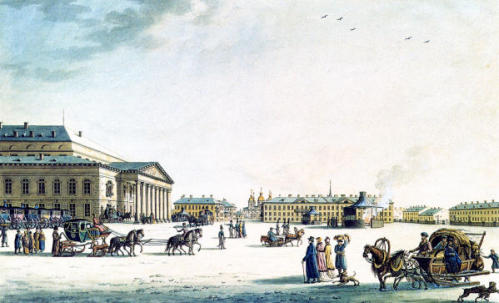St. Petersburg Imperial Bolshoi Kammeny Theatre on:
[Wikipedia]
[Google]
[Amazon]

 The Saint Petersburg Imperial Bolshoi Kamenny Theatre (The Big Stone Theatre of Saint Petersburg, russian: Большой Каменный Театр) was a theatre in Saint Petersburg.
It was built in 1783 to Antonio Rinaldi's Neoclassical design as the Kamenny (i.e., Stone) Theatre; Giovanni Paisiello’s opera ''Il mondo della luna'' was performed at the opening on 24 September. It was rebuilt in 1802 according to the designs of the architect
The Saint Petersburg Imperial Bolshoi Kamenny Theatre (The Big Stone Theatre of Saint Petersburg, russian: Большой Каменный Театр) was a theatre in Saint Petersburg.
It was built in 1783 to Antonio Rinaldi's Neoclassical design as the Kamenny (i.e., Stone) Theatre; Giovanni Paisiello’s opera ''Il mondo della luna'' was performed at the opening on 24 September. It was rebuilt in 1802 according to the designs of the architect

 The Saint Petersburg Imperial Bolshoi Kamenny Theatre (The Big Stone Theatre of Saint Petersburg, russian: Большой Каменный Театр) was a theatre in Saint Petersburg.
It was built in 1783 to Antonio Rinaldi's Neoclassical design as the Kamenny (i.e., Stone) Theatre; Giovanni Paisiello’s opera ''Il mondo della luna'' was performed at the opening on 24 September. It was rebuilt in 1802 according to the designs of the architect
The Saint Petersburg Imperial Bolshoi Kamenny Theatre (The Big Stone Theatre of Saint Petersburg, russian: Большой Каменный Театр) was a theatre in Saint Petersburg.
It was built in 1783 to Antonio Rinaldi's Neoclassical design as the Kamenny (i.e., Stone) Theatre; Giovanni Paisiello’s opera ''Il mondo della luna'' was performed at the opening on 24 September. It was rebuilt in 1802 according to the designs of the architect Thomas de Thomon
Thomas may refer to:
People
* List of people with given name Thomas
* Thomas (name)
* Thomas (surname)
* Saint Thomas (disambiguation)
* Thomas Aquinas (1225–1274) Italian Dominican friar, philosopher, and Doctor of the Church
* Thomas the Ap ...
and renamed the Bolshoi, but burned down in 1811. The building was restored in 1818, and modified between 1826 and 1836 by Alberto Cavos
Alberto Cavos (Russified to Albert Katerinovich Kavos, russian: Альберт Катеринович Кавос, December 22, 1800 – May 22, 1863) was a Russian–Italian architect best known for his theatre designs, the builder of the Mariinsk ...
to accommodate more modern machinery.
Until 1886, the Bolshoi Kamenny Theatre was principal theatre for both the Imperial Ballet and the Imperial Russian Opera.
In 1886 the building was declared unsafe and, at the behest of the theatre director Ivan Vsevolozhsky, the ballet and opera performances moved to the Imperial Mariinsky Theatre, where they have remained ever since. The Imperial Bolshoi Kamenny Theatre was then torn down to make way for the Saint Petersburg Conservatory
The N. A. Rimsky-Korsakov Saint Petersburg State Conservatory (russian: Санкт-Петербургская государственная консерватория имени Н. А. Римского-Корсакова) (formerly known as th ...
.
Notable premieres
Operas * ''A Life for the Tsar
''A Life for the Tsar'' ( rus, "Жизнь за царя", italic=yes, Zhizn za tsarya ) is a "patriotic-heroic tragic opera" in four acts with an epilogue by Mikhail Glinka. During the Soviet era the opera was known under the name ''Ivan Susanin' ...
'' (1836) – Mikhail Glinka
Mikhail Ivanovich Glinka ( rus, link=no, Михаил Иванович Глинка, Mikhail Ivanovich Glinka., mʲɪxɐˈil ɪˈvanəvʲɪdʑ ˈɡlʲinkə, Ru-Mikhail-Ivanovich-Glinka.ogg; ) was the first Russian composer to gain wide recogni ...
* ''Ruslan and Lyudmila Ruslan may refer to:
* ''Ruslan'' (film), a 2009 film starring Steven Segal
* Ruslan (given name), male name used mainly in Slavic countries, with list of people
* Antonov An-124 ''Ruslan'', large Soviet cargo aircraft, later built in Ukraine and ...
'' (1842) – Mikhail Glinka
* ''La forza del destino
' (; ''The Power of Fate'', often translated ''The Force of Destiny'') is an Italian opera by Giuseppe Verdi. The libretto was written by Francesco Maria Piave based on a Spanish drama, ' (1835), by Ángel de Saavedra, 3rd Duke of Rivas, wi ...
'' (1862) – Giuseppe Verdi
Giuseppe Fortunino Francesco Verdi (; 9 or 10 October 1813 – 27 January 1901) was an Italian composer best known for his operas. He was born near Busseto to a provincial family of moderate means, receiving a musical education with the h ...
Ballets
* ''The Pharaoh's Daughter
''The Pharaoh's Daughter'' (russian: Дочь фараона, french: La Fille du pharaon), is a ballet choreographed by Marius Petipa to music by Cesare Pugni. The libretto was a collaboration between Jules-Henri Vernoy de Saint-Georges and Pet ...
'' (1862) – chor. Marius Petipa
Marius Ivanovich Petipa (russian: Мариус Иванович Петипа), born Victor Marius Alphonse Petipa (11 March 1818), was a French ballet dancer, pedagogue and choreographer. Petipa is one of the most influential ballet masters an ...
, mus. Cesare Pugni
* '' The Beauty of Lebanon or The Mountain Spirit'' chor. by Marius Petipa mus. Cesare Pugni.
* '' The Little Humpbacked Horse'' (1864) – chor. Arthur Saint-Léon
Arthur Saint-Léon (17 September 1821, in Paris – 2 September 1870) was the '' Maître de Ballet'' of St. Petersburg Imperial Ballet from 1859 until 1869 and is famous for creating the choreography of the ballet ''Coppélia''.
Biography
He was ...
, mus. Cesare Pugni
* '' La Bayadère'' (1877) – chor. Marius Petipa, mus. Ludwig Minkus
References
Benois, Alexandre: Reminiscences of the Russian Ballet (London, Wyman & Sons, 1941) {{authority control Opera houses in Russia Music venues completed in 1783 Theatres completed in 1783 1783 establishments in the Russian Empire